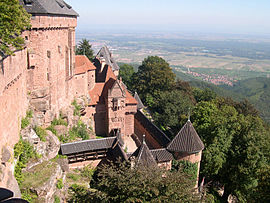- Château du Haut-Kœnigsbourg
-
The château du Haut-Kœnigsbourg (German Hohkönigsburg) is located at Orschwiller, Alsace, France, in the Vosges mountains just west of Sélestat. The castle is nestled at a strategic location on a high hill overlooking the Alsatian plain; as a result it was used by successive powers from the Middle Ages until the Thirty Years' War when it was abandoned. In 1900 it was restored under the direction of Emperor Wilhelm II. Today it is a major tourist attraction, located on the Alsace wine route.
History
It is unknown when a castle was first built on the site. The first explicit mention that is known was in 1147. It took its name from the original Königsburg (German, "King's Castle") in 1192.
In the early thirteenth century the castle passed from the Hohenstaufen family to the Dukes of Lorraine who entrusted it to the Ratsamhausen family who held the castle until the fifteenth century. A coalition of cities attacked and burned the castle in 1462.
The ruins passed to the Thiersteins who rebuilt them after 1479 with a defensive system suited to the new artillery of the time. In 1517 the Thierstein died without an heir and the castle came into the possession of Maximilian I, Holy Roman Emperor.
It was abandoned after the Thirty Years' War because it had been burned and pillaged by Swedish troops after a 52-day siege. For a few hundred years the castle was left unused and became overgrown by the forest. Various romantic poets and artists were inspired by the castle during this time.
It was given by the city of Sélestat to the German emperor Wilhelm II in 1899. Wilhelm wished to create for himself a castle lauding the qualities of the medieval time of Alsace and more generally of German civilization. He hoped it would reinforce the bond of Alsatians with Germany, as they had only recently (1871) been incorporated into the German Reich. The management of the restoration of this fortified castle was entrusted to Bodo Ebhardt. Work proceeded from 1900 to 1908.
Bodo Ebhart's aim was, as near as possible, to rebuild it as it was on the eve of the Thirty Years' War. He relied as much as possible on historical accounts, but, occasionally lacking information, he had to improvise some parts of the stronghold. For example, the Keep tower is now reckoned to be about 14 metres too tall. Wilhelm also encouraged certain modifications which emphasised a romantic nostalgia for Germanic civilization. For example, the main dining hall has a taller roof than it did at the time, and links between the Hohenzollern family with the Habsburgs of the Holy Roman Empire are over-emphasized.
After World War I, the French state confiscated the castle. For many years it was considered fashionable to sneer at the castle in France because of its links to the emperor. Many considered it to be nothing more than a fairy tale castle. However, in recent years many historians have established that, although it is not a completely accurate reconstruction, it is at least interesting for what it shows about Wilhelm II's ideas of the past. Parts of the 1937 movie The Grand Illusion by Jean Renoir were shot at Haut-Kœnigsbourg.
The castle has been listed as a monument historique since 1862. In 1993, it was officially designated as a national historic site by the French Ministry of Culture. Today, it is one of the most famous tourist attractions of the region.
See also
External links
- (French) (English) Official website
- (English) Castle history and access
- (French) Château du Haut-Kœnigsbourg on Ministry of Culture database
- (French) Ministry of Culture - photos
Categories:- Châteaux in Bas-Rhin
- Official historical monuments of France
- Imperial castles
Wikimedia Foundation. 2010.


